Organizational and Economic Mechanism of Managing Aviation Infrastructure for Ship Traffic along the Northern Sea Route
Автор: Chernyak T.A.
Журнал: Arctic and North @arctic-and-north
Рубрика: Social and economic development
Статья в выпуске: 59, 2025 года.
Бесплатный доступ
The development of new territories and international relations requires modernization and the formation of new approaches to managing the implementation of major federal projects. The most important federal project aimed at increasing the competitiveness of the country’s economy in the international arena is the project for the development of transit container transportation along the water area and the Northern Sea Route. Great expectations are associated with the creation of new international economic relations, built using a new transport artery, the communication along which is formed along the shortest route, taking into account the peculiarities of the structure of our planet. The implementation of the project has clear time limits on the stages of its implementation. In 2027, it is planned to start movement along the Northern Sea Route sea transit route (hereinafter referred to as the NSR), which unites the eastern and western extremities of the Eurasian continent in autonomous navigation. By this time, the entire infrastructure of vessel traffic along the NSR should be ready and equipped with the necessary means of communication. This article aims to develop a mechanism for managing the aviation infrastructure capable of meeting the needs for ensuring the continuity of ship traffic along the NSR. The author has systematized the necessary management methods and supplemented the elements of the management subject structure, necessary and sufficient for the timely execution of the organizational decisions planned by the federal program.
Management subject, management object, management mechanism, aviation infrastructure, Arctic zone of the Russian Federation, ship traffic along the NSR
Короткий адрес: https://sciup.org/148331086
IDR: 148331086 | УДК: 338.2(985)(045) | DOI: 10.37482/issn2221-2698.2025.59.63
Текст научной статьи Organizational and Economic Mechanism of Managing Aviation Infrastructure for Ship Traffic along the Northern Sea Route
DOI:
This work is licensed under a CC BY-SA License
The subject of the study is the theory of management of large economic systems, as well as the organization of work of federal executive bodies.
The main objective of the study is to develop a mechanism for managing the aviation infrastructure of ship traffic in the Arctic zone of the Russian Federation along the Northern Sea Route, aimed at resolving organizational and economic problems.
In order to achieve the stated goal, the following tasks were set and consistently solved:
-
• the structure of the management subject was substantiated;
-
• the structure of key management methods was formed;
-
• the main management objects of the aviation infrastructure of the NSR traffic were determined;
-
• the structure and components of the mechanism of management of aviation infrastructure of ship traffic in the Arctic zone of the Russian Federation along the Northern Sea Route, aimed at solving organizational and economic problems, were developed.
Research methods
The work used the method of material systematization to form consistent conclusions about the state of aviation infrastructure in the Arctic and to search for rational solutions for its development.
Literature review
Large-scale problems of socio-economic development of aviation infrastructure of the territories of the Far North are considered in the works of Nenasheva M.V. [4], Donchenko V.K. [5], Karpovich O.G., Shlafman A.I. [6]. In the works of these authors, the country’s priorities in the development of aviation infrastructure of various objects and processes are set. In modern works of foreign authors, one can find a view on the development of aviation infrastructure, the works of such authors as An H. [7], Scott B. [8], I.K. Lim [9] reveal the place and role of state support, as well as areas of active participation of business structures in the development of aviation infrastructure of the northern territories.
Modern researchers of the problems of development of the northern Arctic regions Jahn C., Weigell J., Levina A., Iliashenko V. [10], Karginova-Gubinova V.V., Vasilyeva A.V., Moroshkina M.V., Potasheva O.V. [11], Blagorodov A.A., Vilisova M.L., Prokhorov V.T., Volkova G.Yu. [12], Kuznetsova M.N., Vasilyeva A.S. [13], Poleshkina I.O. [14] identify urgent needs for infrastructure development of the territories of the Arctic zone of the Russian Federation. The importance of aviation component development for economic and cultural relations of the AZRF territories both among themselves and in the organization of economic relations with other regions of the Russian Federation is noted.
Theoretical and methodological issues of NSR infrastructure development are discussed in the works of such authors as: Bashmakova E.P., Ulchenko M.V. [15], Danilin K.P., Ivanova M.V. [16], Novoselov A., Potravny I., Novoselova I. Gassiy V. [17], Radushinsky D.A. [18], Toymentseva I.A., Fedorenko R.V. [19], Topalov R.V., Miroshina E.A. [20], Kholoptsev A.V., Podporin S.A., Olkhovik E.O. [21]. The priority idea of these works is to attract researchers to the problems of substantiating the directions of investment activity in the development of the NSR infrastructure.
Research results
The work contains new solutions for arranging the interaction of three blocks as part of the organizational and economic mechanism for managing the development of aviation traffic infrastructure along all routes of the Northern Sea Route.
The mechanism block “management subject” was revised, which received a clear link to resolving the problems of developing aviation traffic infrastructure along the NSR.
The current structure of the subject of management of aviation infrastructure development in the Arctic zone of the Russian Federation showed insufficient feedback on the processes of managing the aviation infrastructure of ship traffic along the NSR, especially along high-latitude routes.
The new structure of the management subject proposed by the author allows solving this set of problems associated with the new organization of interdepartmental interaction.
Formation of the organizational and economic mechanism for managing the aviation infrastructure of traffic along the Northern Sea Route
The high priority of implementing socio-economic projects for the development of the Arctic zone of the Russian Federation in the context of building new international relations is difficult to overestimate. The development of natural resources of the AZRF is widely performed by private capital. Management of the development of systems, subsystems and elements that form the property complex of entrepreneurial initiatives in the Arctic zone of the Russian Federation is based on regional features of resource distribution and the development of the infrastructure of the Arctic territories. The AZRF include the Arctic territories of nine regions of the Russian Federation: “Murmansk Oblast, Arkhangelsk Oblast, Republic of Karelia, Komi Republic, Nenets Autonomous Okrug, Yamalo-Nenets Autonomous Okrug, Krasnoyarsk Krai, Republic of Sakha (Yakutia), Chukotka Autonomous Okrug” 1.
In turn, “System-forming projects for the socio-economic development of the Arctic zone of the Russian Federation” 2 are implemented under the management of ministries and state corporations through the approval of federal programs for the socio-economic development of the region. The most important federal program for the development of the Arctic zone economy initiated by the state is the Northern Sea Route development plan 3.
The implementation of the NSR development plan implies the involvement of many economic systems in economic relations, the basic of them are enterprises, organizations, departments and ministries responsible for organizing the movement of passengers and cargo along the NSR routes.
A separate place among the tasks of organizing traffic along the NSR is occupied by the organization of the uninterrupted movement of ships along the NSR by providing comprehensive support for the communication of moving ships with continental services.
“Among the many ways of interaction between ships and continental services, the organization of aviation support for the movement of ships along the NSR, or, in other words, the aviation infrastructure for the movement of ships along the NSR (the category, structure and composition of the air transport infrastructure are defined in the Air Code of the Russian Federation) is of great importance” 4 [22].
According to the Air Code of the Russian Federation, the aviation infrastructure includes [22]:
-
• “airfields, heliports, equipped areas for aircraft docking and landing, other facilities necessary for takeoff, landing, taxiing and parking of aircraft” [22];
-
• “airport terminals and other facilities, including capital construction projects, necessary for boarding and disembarking passengers, loading, unloading and storing cargo carried by aircraft, servicing and ensuring the safety of passengers and cargo” [22];
-
• “facilities of the unified air traffic management system” [22];
-
• “ground facilities necessary for the operation, maintenance, construction, reconstruc
tion and repair of airports, airfields and heliports, underground structures and utilities” [22];
-
• “buildings, structures located on the territories of airports, airfields, heliports and intended to ensure aviation security, provision of services” [22];
-
• “ground equipment necessary for the provision of unmanned aircraft systems control lines and control services by suppliers of services (hereinafter — ground equipment for servicing control lines of unmanned aircraft systems and monitoring of unmanned aircraft systems)” [22].
Ibid.
Ibid.
Air Code of the Russian Federation of March 19, 1997 No. 60-FZ. URL:
https://base.garant.ru/10200300/f591b099fe667502efd1ff53a02722e8/ (accessed 30 December 2024).
The aviation component in the infrastructure of traffic along the NSR determines the conditions for direct material and technical interaction between vessels moving along the NSR and continental services [22, Chernyak T.A., p. 423].
The approved resolutions of the Government of the Russian Federation 5, 6 define priorities in the development of sea, river, and rail transport in the implementation of the NSR development plan; due to unforeseen circumstances, the plan 7 did not have an independent place for determining priorities in the development of the aviation infrastructure for the movement of passengers and goods along the NSR. By the Order of the Government of the Russian Federation of August 1, 2022 N 2115-r “On approval of the plan for the development of the Northern Sea Route for the period until 2035”, the tasks of developing the aviation infrastructure were transferred to the department of eight regions (with the exception of the Republic of Karelia), forming the continental infrastructure of the Arctic zone of the Russian Federation as a whole. This step concealed a serious inconsistency in the implementation of management initiatives. The Arctic regions interested in developing interregional exchange, developing the Northern Delivery system, have no direct relation to the implementation of the main goal of the Northern Sea Route development plan
-
8 — ensuring uninterrupted movement of passengers and goods along the shortest sea route from the East to the West of the Eurasian continent and in the opposite direction. These routes are not directly related to the socio-economic development of six of the eight regions of the Arctic zone of the Russian Federation. The Murmansk Oblast and the Chukotka Autonomous Okrug are the extreme points on the route, where caravans can choose the route of lower latitudes and reduce the ice load on their route. In this regard, there is an organizational and technological problem today, consisting in insufficient provision of opportunities for interaction between ships following high-latitude routes of the NSR and continental polar aviation services. The starting point in the escalation of this problem is the insufficient development of the network of Arctic airfields, which affects their readiness to provide support to vessels following the NSR.
Thus, the current circumstances require researchers to pay increased attention to solving problems in managing the development of aviation infrastructure for ship traffic along the NSR. The beginning of the search for solutions to the stated problem is the construction of an organizational and economic mechanism for managing the Arctic aviation infrastructure for ship traffic along the NSR.
Order of the Government of the Russian Federation of August 1, 2022 No. 2115-r “On approval of the plan for the development of the Northern Sea Route for the period until 2035”. URL: (accessed 30 December 2024).
An organizational and economic management mechanism means a set of management subjects and objects related to each other by management methods to achieve the set goals.
In turn, the goals in the development of the aviation infrastructure for traffic along the NSR are divided into three areas:
-
• ensuring the uninterrupted movement of ships along the high latitudes of the NSR by forming a new network of airfields in a quantity and with technical equipment sufficient to cover the entire route of ships along the high latitudes of the domestic northern seas ;
-
• ensuring the maintenance of the functional state, modernization and technical equipment of existing airfields in the Arctic zone involved in ensuring the uninterrupted movement of ships along the NSR, with the necessary means for organizing communications;
-
• ensuring the interconnection and interaction of the aviation infrastructure for the movement of passengers and cargo along all NSR routes with convoys of icebreakers and ships following the directions approved by the main operator of the NSR.
In order to achieve the set goals, the management subject formulates objectives that define the requirements and form the directions of aviation infrastructure development. The implementation of the goals has a strict sequence. Thus, the third goal cannot be achieved until the result is obtained for the first and second ones. The first goal requires the greatest amount of preparatory work, the implementation of which is based on compliance with the requirement for sufficient coverage of the entire NSR route by aviation infrastructure. Achieving the results for the second goal is based on the priorities developed in the course of achieving the results of the first goal.
According to the order of the Government of the Russian Federation dated August 1, 2022 N 2115-r “On approval of the plan for the development of the Northern Sea Route for the period until 2035” 9, the development of infrastructure, including aviation, is allocated to a separate management entity, organized on the basis of institutional principle, under the general title “Preparation of proposals for the development of infrastructure of the transit container operator project based on the results of the pilot project in 2027”, the management subject includes such institutions as the Ministry of Transport of the Russian Federation, the Ministry for the Development of the Far East and the Arctic, as well as the state corporation “Rosatom” (Fig. 1).
The management subject included responsibilities for organizing the development of the entire infrastructure of container ship traffic, including aviation. Modern container ships, carrying 120–150 thousand tons of cargo on board, due to their high draft, are capable of moving only along the high-latitude routes of the NSR. However, in practice, little attention has been paid to the management of the development of infrastructure for its aviation component. During the en- tire period of planning the development of NSR traffic, the structures forming the management subject found it necessary to implement only one decree of the Government of the Russian Federation dated 07.02.2022 N 186-r “On the action plan (“road map”) for the construction (reconstruction) of landing sites in the Arctic zone of the Russian Federation” 10. The implementation period for this order ended in November 2023, and not a single proposal was formed for the development of new aviation infrastructure within a radius closer than 200 km from the coast of the con- tinent.
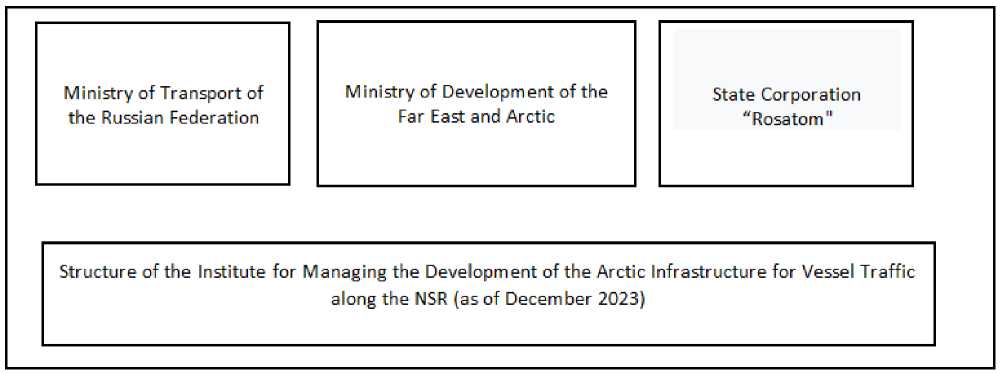
Fig. 1. Unified structure of the institutes included in the management subject developing the concept of the development of the infrastructure for container ship traffic along the NSR. Management mechanism block: “Management subject” 11.
All proposals from the roadmap serve to achieve specific development objectives for the Arctic regions that are not related to cargo traffic along high-latitude transit routes. Moreover, the Rosatom State Corporation, in accordance with the provisions of Federal Law No. 317-FZ of 01.12.2007 “On the State Atomic Energy Corporation Rosatom” 12, has no connection with the aviation infrastructure and does not study the possibilities of its use. “The Ministry for the Development of the Far East and Arctic does not have goals and objectives related to the development of transit routes. The Ministry for the Development of the Far East and Arctic considers the development of infrastructure affecting the activities of seaports assigned to eight Arctic regions. This concludes the authority of the Ministry for the Development of the Far East and Arctic regarding the organization” 13 of traffic along the NSR. The Ministry of Transport does not consider the problem of ensuring uninterrupted vessel traffic along the NSR without posing the problem from the outside. There is no one to designate the problem of international and interregional container traffic along high-latitude NSR routes in the dedicated subject of infrastructure management.
URL: (ac-
URL:
Ibid.
Thus, the mechanism for managing the aviation infrastructure of traffic along the NSR has very weak capabilities in the area of interpreting feedback; in fact, there is simply no feedback on the aviation infrastructure of traffic along high-latitude NSR routes. The aviation infrastructure itself is only a small part of the overall mechanism for managing the infrastructure support of container transportation along the NSR. The mechanism for managing the infrastructure of vessel traffic along the NSR can be illustrated by the following diagram (Fig. 2).
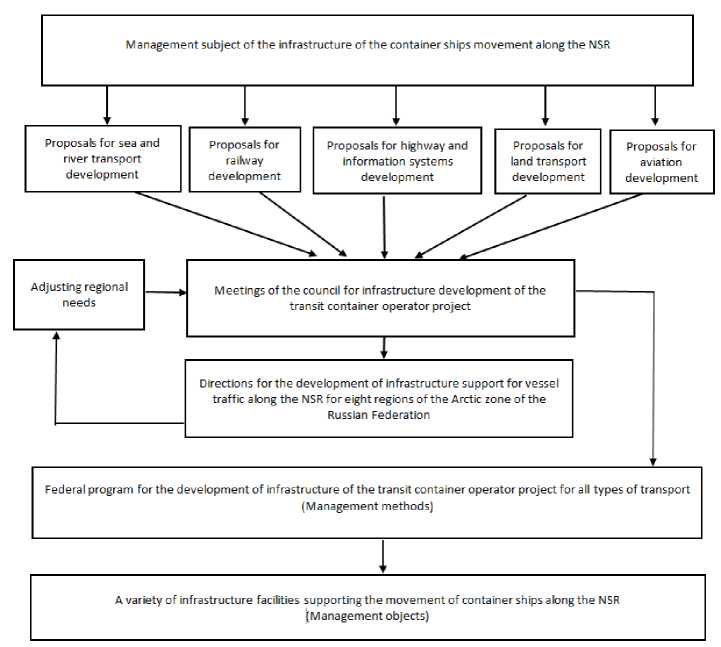
Fig. 2. Mechanism for managing the infrastructure of traffic along the NSR 14.
Currently, the management process has stopped at the stage of approving federal and regional regulations without reference to the goals and objectives of developing a transit high-latitude route for vessel traffic (according to the Order 15 — container ships) along the NSR.
Thus, the problem of ensuring the uninterrupted movement of passengers and cargo along the NSR based on the use of technical means of civil aviation remained outside the boundaries of the activities of the formed entity managing infrastructure projects, which is unacceptable in the context of the imminent launch of the pilot project scheduled for 2027.
In this regard, it is proposed to change the structure of the subject managing the infrastructure support for traffic along the NSR by forming an independent management subject, also formed according to the institutional principle, but with a dedicated function for developing the aviation component, lost in the system of forecasts and plans for the movement of container ships along the NSR. Fig. 3 shows the subject of aviation infrastructure management, which has a composition formed according to the institutional principle, in the interests of container ship traffic along the NSR. The proposed composition of institutions in the management subject forms the first block of the management mechanism for the development of aviation infrastructure for traffic along the NSR — “Management subject”.
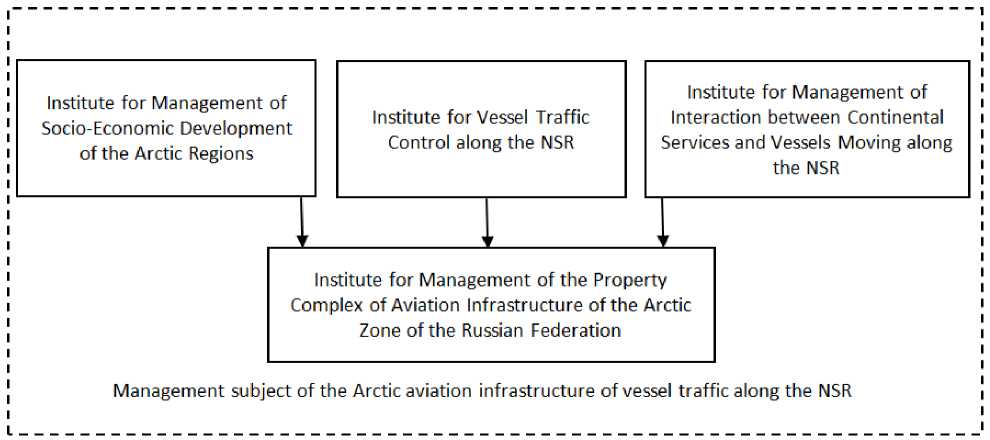
Fig. 3. Block of the management mechanism of the Arctic aviation infrastructure of vessel traffic along the NSR: “Management subject” 16.
Each institute for managing the development of aviation infrastructure for vessel traffic along the NSR forms its own set of requirements for the areas of development of the aviation infrastructure. The composition of the allocated institutes should be formed in accordance with the list of ministries and departments involved in the development of the NSR, according to the Order of the Government of the Russian Federation of August 1, 2022 N 2115-r “On approval of the plan for the development of the Northern Sea Route for the period until 2035” 17. The tasks set by the management subject serve to achieve the goals in three areas of development of the aviation infrastructure of traffic along the NSR identified in the study.
The Institute for Management of Socio-Economic Development of the Arctic Regions (hereinafter referred to as IMSEDAR) will be responsible for initiating and monitoring the construction work in the territories of eight regions to build new airfields in the aviation infrastructure of traffic along the NSR. The IMSEDAR will include the Ministry for the Development of the Far East and the Arctic, the Ministry of Transport of the Russian Federation.
The Institute for Vessel Traffic Control along the NSR (hereinafter referred to as the IVTC) will coordinate the conditions and requirements for route planning, as well as compliance with the northern latitude limits of vessel convoys along the NSR in order to ensure the competitiveness of the transit use of the NSR. The IVTC will include the Ministry of Transport of the Russian Federation and the Rosatom State Corporation.
The Institute for Management of Interaction of Continental Services and Vessels Moving along the NSR (hereinafter referred to as the IMICSVM) will formulate requirements for coordinating the operational interaction of continental services and vessels moving along the NSR, by approving regulations and protocols for the implementation of communications in all possible areas of vessel traffic support. The IMICSVM will include the Ministry of Transport of the Russian Federation, the Ministry of Emergency Situations, the Rosatom State Corporation, and the Rostec State Corporation.
The formed conditions of construction works, protocols of communications implementation, as well as requirements to the organization of interaction between vessels and continental services are accumulated and analyzed by the Institute for Management of the Property Complex of the Aviation Infrastructure of the Arctic Zone of the Russian Federation (hereinafter referred to as IMPCAI). On the basis of consolidated data and in accordance with the general goal of developing the NSR transit route, the IMPCAI develops requirements for building the concept of developing the aviation infrastructure for vessel traffic along the NSR. This institute will include the Ministry of Transport of the Russian Federation, the Ministry for the Development of the Far East and the Arctic, and the Ministry of Emergency Situations.
The control action is implemented by standard management methods, including orders, decrees, implying control over their fulfilment, and therefore, largely relying on the rational organization of feedback with the second block — “Management methods” (Fig. 4).
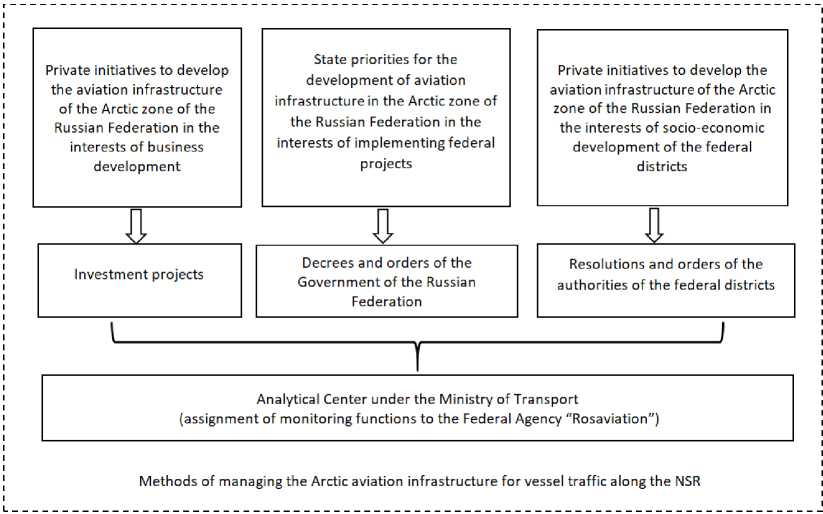
Fig. 4. Block of the management mechanism of the Arctic aviation infrastructure of vessel traffic along the NSR: “Management methods” 18.
-
18 Compiled by the author.
Management methods have two stages of formation and assume the consolidation of the monitoring function within the process of making management decisions. It is important to note that the acute problem of today is the implementation of steps to form a concept for the development of aviation infrastructure for vessel traffic along the NSR.
The concept obtained as a result of the composition of data on the development of aviation infrastructure forms feedback with the management entity, which approves its implementation and gives instructions for the start of the implementation of economic activities necessary for the development of aviation infrastructure for vessel traffic along the NSR. The interrelation of the block of the management subject and the block of management methods in the mechanism of management of the Arctic aviation infrastructure of ship traffic along the NSR takes place in the order of implementing the development goals described above.
The result of the impact of management methods on management objects is the implementation of decrees, orders and projects for the development of the property complex of Arctic airfields, as well as the creation of new protocols of interaction between the Arctic infrastructure and ships travelling along the NSR.
The management objects in the system of relationships aimed at developing the aviation infrastructure for traffic along the NSR are both new territories of the Arctic zone, where the required number of Arctic airfields are to be built, and the existing property complexes of the main airfield operators, under whose management the equipment modernization processes are to be completed (see Fig. 5).
For all types of property complexes in the aviation infrastructure support system, programs for technical and technological equipment of the airfield with the necessary means for organizing and implementing interaction between vessels following NSR routes and continental services should be implemented.
|
New territories for the construction of airfields, taking into account the autonomy of operation in Arctic conditions |
Airfields with an outdated property complex that need modernization for new goals and objectives |
Airfields that require additional technical equipment to implement interaction with vessels travelling along the NSR |
I Management objects of the Arctic aviation infrastructure of vessel traffic along the NSR ।
L______________________________________________________________________________J
Fig. 5. Block of the management mechanism of the Arctic aviation infrastructure of vessel traffic along the NSR: “Management object” 19.
Thus, the mechanism for managing the development of the Arctic aviation infrastructure for vessel traffic along the NSR will have the following structure and will be implemented due to the established relationships reflected in Fig. 6.
Statement of the problem
1. Concept approval
Block: "Management subject” of the Arctic aviation infrastructure for vessel traffic along the NSR
2. Action plan approval
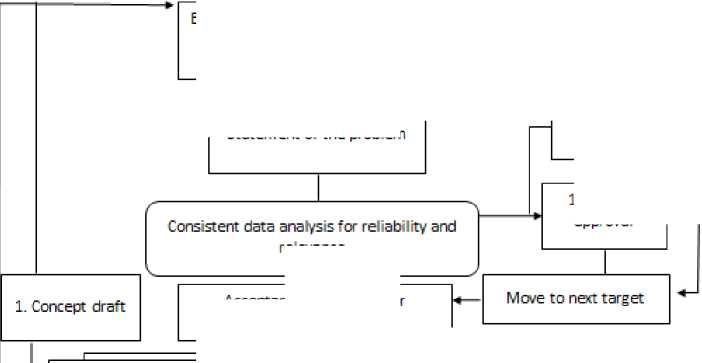
relevance
Acceptance of the goal for fulfillment
1. Ensure uninterrupted movement of vessels along the high latitudes of the Northern Sea
Route through the formation of a new network of airfields, in quantity and technical equipment sufficient to cover the entire route of vessels along the high latitudesof the domestic northern seas
2 Ensure the maintenance of the functional condition, modernization and technical equipment of existing airfields in the Arctic zone
3. Ensure the interconnection and interaction of the aviation infrastructure for the movement of passengersand cargo along all NSR routes w ith ship convoys
Block: "Management methods" of the Arctic aviation infrastructure for vessel traff ic along the NSR
Block "Management methods” of the Arct ic aviation infrastructure for vessel traff ic along the NSR
Block: "Management methods” of the Arct ic aviation infrastructure for vessel traff ic along the NSR
|
Concept for the development of aviation infrastructure for vessel traffic along the NSR |
Action plan for the reconstruction of landing sites |
2. Draft action plan
Approval by the Federal Agency "Rosaviation" of requirements for organizing the interaction of the aviation infrastructure for the movement of passengers and cargo along all NSR routes w ith convoys of shins
Block "Management objects" of the Arctic aviation infrastructure for vessel traffic along the NSR
Directions for actions
Adjustment of federal programs, formation of the new orders for the development of aviation infrastructure
Fig. 6. Mechanism of management of the Arctic aviation infrastructure of ship traffic along the NSR.
The main starting point for the organizational and economic mechanism is the problem of managing the aviation infrastructure of ship traffic along the NSR. The solution of this problem forms three directions of management goals, which are consistently connected to the management mechanism through the creation of a concept for the development of aviation infrastructure and a plan for the reconstruction of landing sites in the Arctic zone of the Russian Federation, capable of providing support to vessels following all NSR routes.
Conclusion
The construction of a mechanism for managing the Arctic aviation infrastructure for vessel traffic along the NSR required a restructuring of the composition of the management subject of
SOCIAL AND ECONOMIC DEVELOPMENT
Tatyana A. Chernyak. Organizational and Economic Mechanism of Managing … the infrastructure support for vessel traffic along the NSR by justifying the need to allocate an independent structure of the subject managing the Arctic aviation infrastructure for vessel traffic along the NSR. The management subject of the Arctic aviation infrastructure of vessel traffic along the NSR acts as the first block in the management mechanism of the Arctic aviation infrastructure of vessel traffic along the NSR.
Initialization of identical management decisions by established methods in the new management mechanism of the Arctic aviation infrastructure of vessel traffic along the NSR formed a set of key management methods. The array of administrative decisions formed in accordance with the new scheme of operation of the management mechanism of the Arctic aviation infrastructure of vessel traffic along the NSR forms the second block of the mechanism — management methods.
In order to fulfil the goals of the development of the aviation infrastructure of vessel traffic along the NSR, the management objects were generalized as an independent third block in the new management mechanism of the Arctic aviation infrastructure of vessel traffic along the NSR.
The developed scheme of the organizational and economic management mechanism of the Arctic aviation infrastructure of vessel traffic along the NSR completely covers the most rational ways to solve the problems set in the study.
The main result of the work of the management mechanism of the Arctic aviation infrastructure of vessel traffic along the NSR is a new approach to the development of regulatory documents that define the requirements for the number, locations and technical characteristics of the development of airports in the infrastructure of ship traffic along the NSR. Based on these documents, the developers of the Arctic federal districts and the main operators of airfields will be able to begin implementing their functions.
In turn, the work of the aviation infrastructure in accordance with the established management mechanism of the Arctic aviation infrastructure of vessel traffic along the NSR will be able to ensure the uninterrupted movement of ships along all NSR routes.


